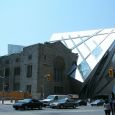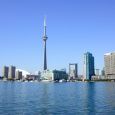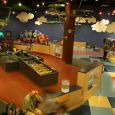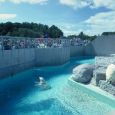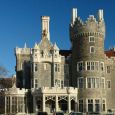Toronto
Advertisement
By Air
Toronto's primary airport is Toronto Pearson International Airport (YYZ), straddling Toronto's western boundary with Mississauga. Pearson's air traffic is just under 32.3 million passengers in 2008,and it is the world's largest originator of air traffic into the United States. It is the busiest airport in Canada and is the largest hub for Air Canada. It is the busiest airport in the Americas outside of the United States. It serves more passengers than all airports in Central America combined.
Ferries
The principal ferry service to the Toronto Islands is provided by the city's Parks, Forestry and Recreation division. Ferries run year-round from the Toronto Ferry Docks at the foot of Bay Street to Hanlan's Point, Centre Island, and Ward's Island. A very short ferry run is provided by the Toronto Port Authority from the foot of Bathurst street to the island airport. The port authority announced in February 2006 that it would expand this service as part of a deal to expand flights out of the airport
Subway
The backbone of the TTC is a basic subway system with two main lines, the U-shaped Yonge–University–Spadina Line and the east-west Bloor–Danforth Line, running along principal streets and connecting Toronto's outlying areas with its downtown core. Each line also connects to a secondary feeder near one of its outer ends: the Sheppard subway line in the north and the Scarborough RT in the east, making it the most extensive rapid transit system in Canada, despite the fact that the four lines provide a very limited coverage of the city.
Bus and streetcar
The rest of the city is primarily served by a network of about 150 bus routes, many of them forming a grid along main streets, and all of them (except for the #99 and #171 routes) connecting to one or more subway or RT stations. A more distinctive feature of the TTC is the streetcar system, one of the few remaining in North America with a substantial amount of in-street operation. The city of Toronto has the second largest streetcar system in the world behind Melbourne, Australia. Most of the 11 streetcar routes are concentrated in the downtown core, and all connect to the subway.
Advertisement
Royal Ontario Museum
The natural history section concentrates primarily on the evolution of life on earth. Among its highlights are a superb display of dinosaur skeletons and a series of fascinating wildlife dioramas (including some featuring mammals native to Ontario).
Also of great interest are the museum's gem collection and the sections devoted to the pre- and early history of Ontario (with e.g. Indian rock drawings) and the period since the arrival of the first Europeans. Then there are the exhibitions on the Mediterranean World (including the civilizations of ancient Egypt, Greece and Rome) and European decorative crafts since the 17th c., each occupying several rooms. Many rewarding hours could be spent just looking round the wonderfully comprehensive textiles section and the small collection of musical instruments!
The Royal Ontario Museum is one of Toronto's most renowned attractions, with a strong collection representing both art and science. The building underwent renovations and a major expansion project that was completed in 2007. The Michael Lee-Chin Crystal, a modern glass extension, was added on to this very traditional building creating a strong achritectural contrast.
The museum presents a variety of themed galleries that include World Culture Galleries, Natural History Galleries, Hands-on Galleries, and Exhibitions Spaces, with special exhibitions held regularly.Hobbies & Activities category: Dinosaur collection or display; Ancient Egyptian art, artifacts; Minerals, geology attraction, mining; Major world-scale museum; Western hemisphere native art, artifacts; Aviary, bird museum or exhibit; Paintings, art collections; Musical instruments museum; Jewish site or artifact collection; Natural history museum; Oriental art; Science, technology attraction or museum
CN Tower
The 553m / 1815ft high CN Tower was constructed between 1972 and 1976. This modern landmark beside Lake Ontario is more than two and half times the height of Stuttgart's television tower (which, built just 20 years earlier, was the prototype of all such towers). About two-thirds of the way up the Tower (335m / 1100ft) the seven-story "Sky Pod" houses a revolving restaurant, and observation platforms from which, in clear weather, views extend for 120km / 75mi. On occasions it is even possible to make out the cloud of mist and spray which hangs above the Niagara Falls. Anyone so inclined can take the lift even further up, to the 447m / 1470ft high Space Deck, above which rises the Tower's enormous aerial.
Toronto Zoo
Toronto's huge zoo with its collection of several thousand animals is situated on the Red River some 40km / 25mi north-east of the city center. The zoo is divided into four sections, each representing a major region of the globe. The North American section is unique, enthralling the visitor with its spacious grizzly bear enclosure, vast bison park and impressive polarium, etc.
Some of the other highlights at the Toronto Zoo include the African Savanna, Great Barrier Reef, and the Gorilla Rainforest.
Ontario Science Centre
The Ontario Science Center occupies a site overlooking the Don Valley, about 10 km/6 mi north-east of the city center. Designed by the virtuoso architect Raymond Moriyama this extremely modern building was completed in 1969. Visitors to the Center are brought face to face with the latest developments in e.g. laser technology, telecommunications, optics, biology, atomic physics, space travel and meteorology, all presented in an absorbing and imaginative way. The emphasis is very much on visitor participation, with many inter-active displays and widespread use of suitably installed computing and other equipment.
The Ontario Science Center is largely family oriented with many interesting exhibits to entertain children.
Casa Loma
Standing in beautifully kept grounds just across the Avenue from Spadina Mansion, Casa Loma is an extraordinary building somewhat reminiscent of a medieval castle. It was originally constructed for Sir Henry Pellatt, an eccentric Canadian multi-millionaire who was among the first to recognize and exploit the money-making potential of the Niagara Falls.
With close to 100 rooms (including three dozen bathrooms) the house is now a museum. Step back in time to a period of European elegance and splendour. Canada's foremost castle is complete with decorated suites, secret passages, an 800-foot tunnel, towers, stables, and beautiful 5-acre estate gardens.
Information not available
December - February -> -7(°C) - Winter
June - August -> 25(°C)
Advertisement

